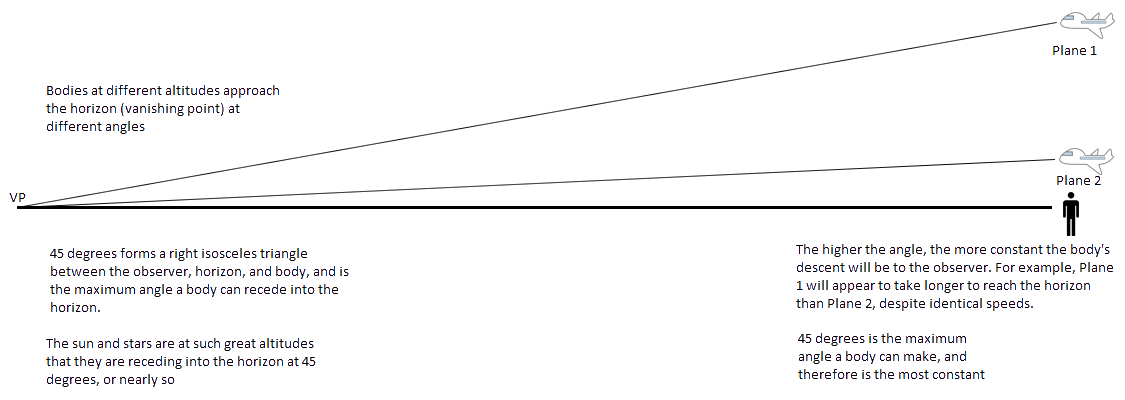Difference between revisions of "Constant Speed of the Sun"
Tom Bishop (talk | contribs) |
Tom Bishop (talk | contribs) |
||
| Line 3: | Line 3: | ||
'''A.''' The sun moves constant speed into the horizon at sunset because it is at such a height that already beyond the apex of perspective lines. It has maximized the possible broadness of the lines of perspective in relation to the earth. It is intersecting the earth at a very broad angle. | '''A.''' The sun moves constant speed into the horizon at sunset because it is at such a height that already beyond the apex of perspective lines. It has maximized the possible broadness of the lines of perspective in relation to the earth. It is intersecting the earth at a very broad angle. | ||
| − | It's widely observable that overhead receding bodies move at a more constant pace into the horizon the higher they are. For example | + | It's widely observable that overhead receding bodies move at a more constant pace into the horizon the higher they are. For an example imagine that someone is flying a Cessna into the distance at an illegal altitude of 700 feet. He seems to zoom by pretty fast when he is flies over your head, only slowing down when he is off in the far distance. |
| − | + | Now consider what happens when a jet flies over your heat at 45,000 feet. At that altitude a jet appears to move very slowly across the sky, despite that the jet is moving much faster than the Cessna. With greater altitude the plane seems to move more consistently across the sky. It does not zoom by overhead, only seeming to slow when in the far distance. | |
| + | When a body increases its altitude it broadens its perspective lines in relation to the earth and the observer, and thus appears to move slower and at a more constant pace into the horizon. In FET is that the stars are at such a great height that they have maximized the perspective lines. They are descending into the horizon at a consistent or near consistent velocity. As consequence they do not slow down in the distance by any significant degree, and hence the stars do not appear to change configuration and build up in the distance, nor do the sun or moon appear to slow when they approach the horizon. | ||
[[File:Perspective_speed.png]] | [[File:Perspective_speed.png]] | ||
| + | |||
| + | The rate of descent of two bodies at different altitudes is more constant because it take a lot longer for a high altitude body to reach the horizon than it does for a low altitude body. The higher a body is, the broader its perspective lines, the longer and more constant it will appear to approach the horizon to the observer. | ||
==See also:== | ==See also:== | ||
Revision as of 15:57, 15 November 2012
Q. If the sun is disappearing to perspective, shouldn't it slow down as it approaches the horizon?
A. The sun moves constant speed into the horizon at sunset because it is at such a height that already beyond the apex of perspective lines. It has maximized the possible broadness of the lines of perspective in relation to the earth. It is intersecting the earth at a very broad angle.
It's widely observable that overhead receding bodies move at a more constant pace into the horizon the higher they are. For an example imagine that someone is flying a Cessna into the distance at an illegal altitude of 700 feet. He seems to zoom by pretty fast when he is flies over your head, only slowing down when he is off in the far distance.
Now consider what happens when a jet flies over your heat at 45,000 feet. At that altitude a jet appears to move very slowly across the sky, despite that the jet is moving much faster than the Cessna. With greater altitude the plane seems to move more consistently across the sky. It does not zoom by overhead, only seeming to slow when in the far distance.
When a body increases its altitude it broadens its perspective lines in relation to the earth and the observer, and thus appears to move slower and at a more constant pace into the horizon. In FET is that the stars are at such a great height that they have maximized the perspective lines. They are descending into the horizon at a consistent or near consistent velocity. As consequence they do not slow down in the distance by any significant degree, and hence the stars do not appear to change configuration and build up in the distance, nor do the sun or moon appear to slow when they approach the horizon.
The rate of descent of two bodies at different altitudes is more constant because it take a lot longer for a high altitude body to reach the horizon than it does for a low altitude body. The higher a body is, the broader its perspective lines, the longer and more constant it will appear to approach the horizon to the observer.
See also:
- The Setting of the Sun
- Magnification of the Sun at Sunset, or how the sun maintains its size throughout the day.

